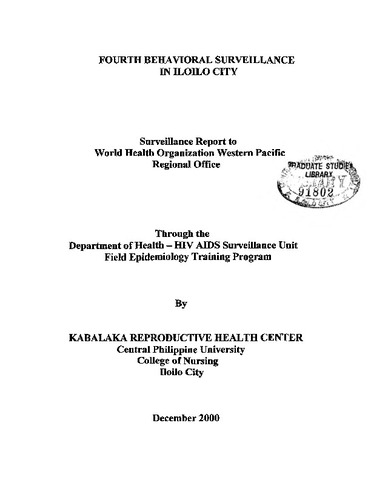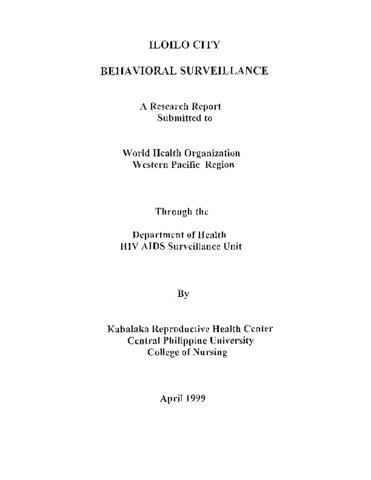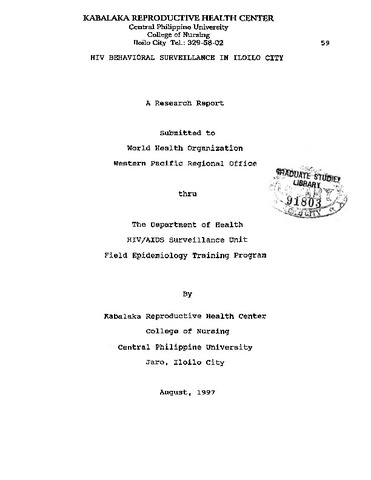| dc.description.abstract | Background/Rationale of the Study
Behavioral surveillance in Iloilo City started on October 1997 when the Department of Health- Field Epidemiology Training program considered Iloilo City as one of their sentinel site. It should be noted that the first HIV AB(+) female sex worker was found in this city last 1987.
The third behavioral surveillance among the female sex workers and the second round among the men having sex with men showed the following results.
1. The majority of the female sex workers belonged to the 20-24 years old bracket, had high school education, and was single. The majority of MSMs belonged to the 15-19 years old bracket, had reached college level, and were single.
2. There was a decreasing trend of having sex with their regular sex partners among the RFSW and an increasing trend of having sex with their regular partner among the FFLSW and the MSMs. There was an irregular trend in having sex with their non-regular sex partner among the female sex partners while a slight decrease in having sex with their non-regular sex partners was noted among the MSMs.
3. There was a steady increased trend of “always” using a condom among the female sex workers while there was slight increase among the MSMs.
4. There was a steady increased trend of using condom among the female sex workers with their regular sex partners while there was no increase on the part of the MSMs.
5. There was a steady increasing trend of condom usage with their non-regular sex partners among the RFSW while there was an irregular pattern trend of condom usage among the FFLSW in having sex with their non-regular sex partners. There was a slight increase of the practice using a condom with their non-regular sex partners among the MSMs.
The majority of the MSMs did not use any condom while doing penetrative sex with their non-regular sex partners.
6. There was an increase in the number of MSMs who had had a female sex partner and the majority did not use condom in having sex with their female sex partners.
7. There was a decreasing number of RFSW who claimed of experiencing signs and symptoms of STDs while there was an increasing trend among the FFLSW. There was an increasing number of MSMs who experienced signs and symptoms of STDs on the second round than there were on first round.
8. The majority of the subjects who had signs and symptoms of STDs sought consultation at the Social Hygiene Clinic.
9. There was a steady increase in the number of female sex workers who were able to identify the three correct practices that could protect an individual from STD/HIV/AIDS.
10. The top five most popular sources of information were television, radio, friends, health workers, and magazines.
11. The majority of the subjects have been engaged in sex work less than a year.
12. The majority of the subjects were interviewed for the first time. The results of the last behavioral surveillance showed that there was a need to continue monitoring the behavior of the different subjects as a source of information in designing preventive measures against STD/ HIV/ AIDS.
Objectives of the study
Behavioral surveillance was conducted in 2000 to establish trends in the last four rounds among the female sex workers and the last three rounds among the men having sex with men.
Specific objectives:
To establish trends on the following areas:
1. Number of sexual partners
2. Knowledge about on the three correct practices that can protect the individual from contacting STD/HIV/AIDS
3. Consistency of condom use among the subjects with their regular and non-regular sex partners.
4. Number of subjects with their self-proclaimed signs and symptoms of STDs
5. Sources of STD/HIV/AIDS information among the subjects
6. Health seeking behavior among the subjects from the last four rounds among the female sex workers and the last three rounds among the men having sex with men
7. the length of time the subject has engaged in sex work
8. the number of times the subject was interviewed
METHODOLOGY
Research Design
This is a descriptive research study utilizing an interview schedule designed by the DOH- FETP and was administered through face-to-face, in-depth interviews. The same interview schedule was used during the last three rounds of surveillance.
Sampling of Population and Identification Area
The surveillance utilized an interview schedule devised by the DOH- FETP. The surveillance involved 360 subjects; each of the three groups (the registered female sex workers, female freelance sex workers, and men having sex with men) was a sample of 120 subjects.
The registered female sex workers (RFSW) were taken from registered entertainment establishments which was categorized into three; namely; night clubs, KTV Karaokes, and massage parlors. The same registered establishments were included on the third behavioral surveillance. The number of employees in every establishment was listed until the actual total number of registered female sex workers was determined. Only 120 RFSW was included.
The sample size was based on DOH Manual of Operations for HIV Behavioral Surveillance, for which the subjects were estimated using the Prevalence Survey of Expected Prevalence Rates of STD. After the list was completed, a proportional number of sex workers in each of the identified establishments determined. Simple randomization by means of the lottery method was done to identify who would be included in the surveillance in each establishment.
The female freelance sex workers (FFLSW) were located from casas, beer houses, and the different streets in Iloilo City. These were the same sites that were taken on the last three rounds. The data gatherers were detailed for six hour in each different site. All the subjects who meet the inclusion criteria and agreed voluntarily were interviewed during the allocated hours. This method was repeated until the 120 FFLSW was reached.
The men having sex with men who caters for pleasure and those male sex workers who cater to both male and female customers, and who had penetrative sex for the last month were included.
The MSMs were located on the different streets of the city proper, La Paz area and Molo district. A snow ball method was done on the said identified areas which were the same areas as of last year (1999). The data gatherers stayed in the different sites for six hours until the 120 subjects were reached.
The number of subjects who refused to answer the interview-schedule was noted. There was no refusal among the female subjects but there were 19 or 13. 66 % of MSMs who refused to participate in the surveillance. The following were their reasons of not participating. There were seven subjects who said they were in a hurry or busy in their work, six subjects who said they were ashamed. There were two who did not have any penetrative sex for the whole month, three who refused without giving any reason and further said they were waiting for somebody and one MSM said he was tired of answering questions.
Statistical Tools
The data were processed by using the Epi Info 6 upgraded program. Frequency count and percentages were used in the analysis of data in this study.
Summary of Findings
1. Majority of RFSW were in the age bracket o f20-24 years old, single, had reached high school with a median partner of 1-3. The majority of FFLSW were in the age group of 20-24 years old, were at the high school level of education, single, and with a median sex partners of 3-4. The MSMs were on the age group of 15-19 years old, reached high school, single, and with a median sex partners of 2-4.
2. There was an irregular pattern on the trend of sexual contact among the subjects to both regular and non-regular sex partners.
3. There was a decrease on the consistent use of condom on the fourth round among the subjects. There was an increase number of subjects who claimed of “sometimes” using condom and slight decrease of subjects who ‘never” use condoms on the fourth round.
4. Although there was an increase on the use of condom with the regular partner a sex partner on the third round, there was a decrease on the use of condom on the fourth round to the three target groups.
5. A decrease of condom use among the subjects with their non-regular sex partner was noted on the fourth round.
6. Majority of the MSMs did not have female sex partners.
7. Majority of the MSMs with female sex partners did not use condom.
8. There was an increase number of RFSW who claimed of having signs and symptoms of STDs but a decreased number between the FFLSW and the MSMs six months prior to the surveillance.
9. There was a decrease on the number of RFSW who experienced pain or burning sensation when urinating. There was a slight increased in the number of those who had the yellowish discharges from genital areas. However, there was a slight increased in the number of subjects who were suffering from sore or lesions in the ano-genital areas. There was fewer number of FFLSW who experienced pain or burning sensations when urinating and claimed of having sores or lesions on the fourth round. There was a slight increase in the number of FFLSW who noticed yellowish abnormal discharges. There was a decreased in the number of MSMs who experienced on the three major signs and symptoms of sexually transmitted diseases on the fourth round.
10. Majority of the subjects used prohibited drugs such as Shabu, Marijuana, Cocaine, and mixed drug. There were four subjects who used in intravenous drug but did not share nor reused needle and syringes.
11. The female sex workers sought treatment at the Social Hygiene clinic but the MSMs sought treatment from their friends, hospitals and private doctors. Few MSMs ignored their signs and symptoms of STDs.
12. There was a decrease on the knowledge of sex workers on the three correct practices that could protect the subjects from being infected with STDs.
13. The majority of the subjects received STD/HIV/AIDS information from television, health workers, radio, from people in their workplace, and through friends. The five most popular sources of information among the RFSW were television health workers, radio, peers in workplaces, and friends. The FFLSW mentioned health workers, radio, and or television, posters, friends, and people in their workplaces. The men, on the other hand, enumerated the five most popular sources of information as television, radio, magazine, schools, and friends.
14. Most of the female sex workers had been in sex work from 1 to 6 months. The callboys had engaged in this kind of work from 7 to 12 months.
15. More than 2/3 of the subjects interviewed for the first time.
Action
Based on the above findings, there is a need to continue increasing the awareness of the risk groups. This could be done through the full implementation of the newly approved Ordinance 045 that mandates compulsory education and counseling of all owners, managers, employees, and gatekeepers of all registered entertainment industries before they can be allowed to work or operate such in their establishments.
There is a need to produce/review existing IEC materials that can help sustain behavior change. Since there is an increasing number of MSMs with female partners, men involvement in the STD/HIV/AIDS prevention program should be encouraged. It is also recommended that MSMs should be included in the serological surveillance. | en_US |






